Space Inspectors
A recent report on the successful testing of a Russian satellite inspector is not news, but an official recognition of a fact known for several years. The idea of inspecting foreign satellites appeared at the dawn of the space age, and now the United States, Russia and China are developing, testing and commissioning their satellites for this purpose.

Photo of satellite Tango from satellite Mango, project PRISMA
The Kosmos-2519, about which the news is about, is already the fourth mysterious Russian satellite in recent years. Before it, the object originally classified as garbage in 2013 turned out to be a satellite "Kosmos-2491", which began transmitting telemetry. Then they began to move in orbit Kosmos-2499 (launched in 2014, and I already talked about it) and Cosmos-2504 (2015). The appearance and purpose of the satellites were not officially announced, but much could be said by their behavior in orbit. From the open-access TLE orbit elements, it was possible to determine that the satellites were moving closer to other Russian objects. Cosmos-2499 approached close to the Briz-KM upper stage, which brought it into orbit. “Cosmos-2504” also got close to its accelerating unit and, it seems, hit or docked with it - the orbit of the accelerating unit has changed a little. In 2017, Cosmos-2504 accidentally or intentionally flew about a kilometer from Chinese space debris.
Further, the work of "Cosmos-2519" was covered better than the work of previous ones. As early as June 23, immediately after launch, information appeared that the satellite would be engaged in shooting both the earth and space objects. A month later, it was openly announced that the satellite-inspector had separated from the spacecraft. By TLE, it became clear that the inspector is moving closer to the Cosmos-2486 device - the Persona No. 2 optical reconnaissance satellite. Then the inspector began to fly around the wearer, appearing either in front or behind.
')
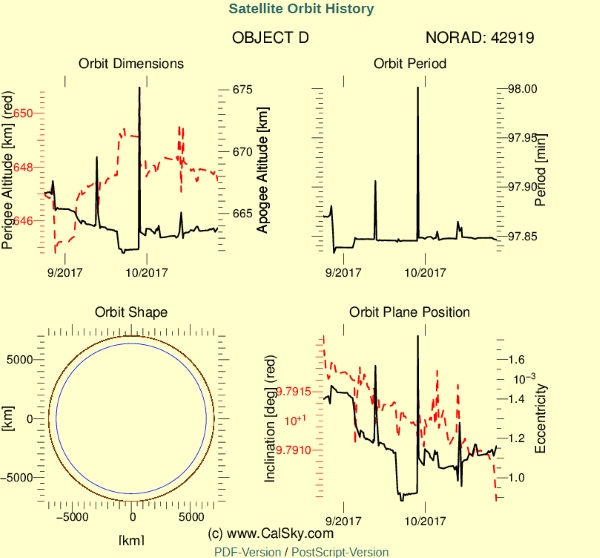
Recent inspector orbit changes
It is worth noting that the first three "Cosmos" most likely belonged to the same type, and -2519 may be another device. The fact is that Cosmos -2491, -2499, -2504 were displayed on the Rokot carrier rocket with associated load with three Gonets / Rodnik communication satellites. But -2519 was launched by another carrier rocket, the Soyuz-2.1v, alone. Therefore, if the first three "Cosmos" most likely have a mass of no more than 50 kg and in size should not differ much from the Jubilee satellite, which was derived in the same way, then -2519 may be a new platform.
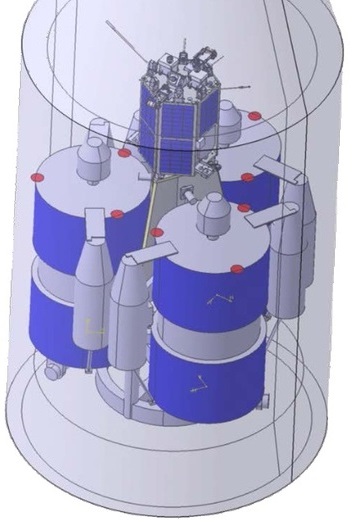
Three "messengers" / "Spring" and "Jubilee" under the fairing, drawing SibSAU
In the journal "Vestnik NPO im. Lavochkina ” No. 4 for 2015 you can find a reference to the platform“ Karat-200 ”, which is designed to monitor satellites in the GSO, Perhaps it is precisely what Kosmos-2519 is experiencing. Also, various sources mention the names Voltage, 14F150, and Nivelir, but for now this is a guess.
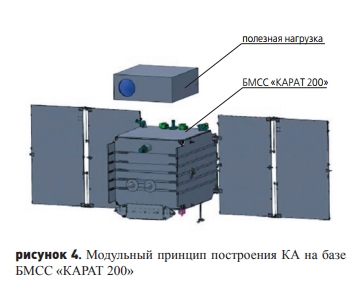
Platform "Karat-200" magazine "Bulletin of the NPO. Lavochkin "
Inspector satellites are being actively developed by the United States and China.
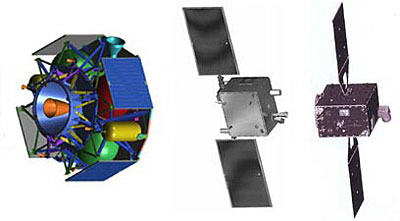
MiTEX satellites and upper stage, DARPA pattern
In 2006, two MiTEX satellites were launched to covertly approach objects in geostationary orbit. The small size of the apparatuses was supposed to ensure the small size, however, there is information that the Russian space monitoring systems were able to detect them.

PAN Satellite near Pakistan PakSat-1, photo by Marco Langbroek
Since 2009, it has been moving in geostationary orbit and has been listening to other satellites of the American electronic intelligence unit PAN. Over the years, he managed to visit at least nine points.
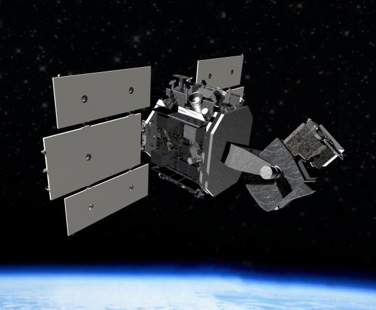
SBSS satellite, Boeing pattern
In 2010, a technological demonstrator, Space Based Space Surveillance, went to orbit, with a 30-centimeter telescope and a 2.4 megapixel sensor mounted on it. Already 4 Geosynchronous Space Situational Awareness Program satellites (“Geosynchronous Situation Awareness Program”) were created and successfully launched on its basis, the parameters of which are secret. The satellites are in orbit close to the geostationary, and are designed to monitor other satellites in the geostationary orbit.
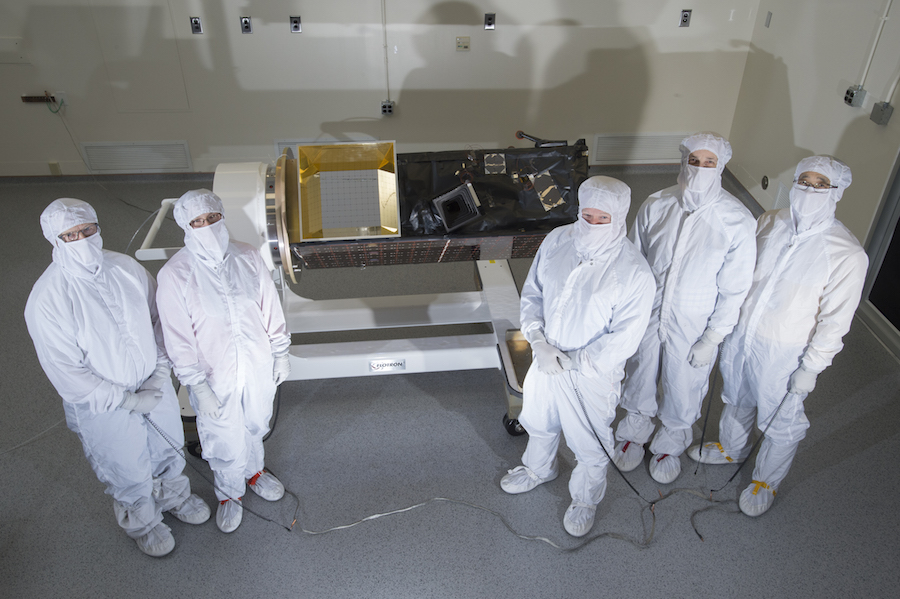
ORS-5, photo by MIT Lincoln Laboratory
In 2017, the ORS-5 satellite with a large telescope went into orbit to observe the devices in geostationary orbit.

X-37 Photo by Boeing
And, of course, the most famous device is the reusable X-37 spaceplane. His capabilities are not officially announced, but he can launch satellites, change orbit, and carry reconnaissance equipment. The possibility of landing with a cargo means that he can even steal other people's satellites, but in a peaceful situation such an action cannot be hidden, and it will cause an international scandal.
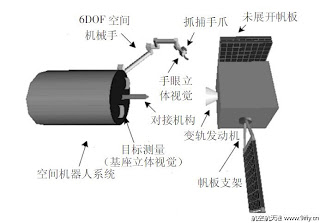
Chuang Xin 3 (CX-3) and Shiyan 7 (SY-7), Figure 9iffy.cn
In China, experiments with satellite convergence and testing of a robotic manipulator using Chuang Xin 3 (CX-3), Shiyan 7 (SY-7) and Shijian 15 (SJ-15) devices were carried out. Officially, the devices deal with the problem of space debris, but these technologies may have a dual purpose. In 2010, SJ-6F and SJ-12 were deliberately confronted as part of some experiments.
The question regularly arises whether inspection satellites can be used to destroy foreign satellites. Theoretically, this is quite possible, but in reality they are not particularly suitable for this - special anti-satellite missiles can destroy an enemy satellite faster than the inspector gets to him. But this, of course, is possible only in conditions of war. But the slow inspector will be useful for the tasks of external inspection and, in particular, for eavesdropping the satellite-target radio communications with ground control points. In addition, it can work for years and receive information about dozens of goals. At the same time, there are no legally formal claims.
I think in the future there will be more satellite inspectors and they will develop. The reason is simple - they do not carry traces of weapons and do not fall under the treaties banning the militarization of space, and thus are useful for reconnaissance. But it makes no sense to get upset - the technologies used in them can be useful for peaceful purposes, for refueling and maintaining satellites in orbits, as well as in the fight against space debris.

Photo of satellite Tango from satellite Mango, project PRISMA
Open secret
The Kosmos-2519, about which the news is about, is already the fourth mysterious Russian satellite in recent years. Before it, the object originally classified as garbage in 2013 turned out to be a satellite "Kosmos-2491", which began transmitting telemetry. Then they began to move in orbit Kosmos-2499 (launched in 2014, and I already talked about it) and Cosmos-2504 (2015). The appearance and purpose of the satellites were not officially announced, but much could be said by their behavior in orbit. From the open-access TLE orbit elements, it was possible to determine that the satellites were moving closer to other Russian objects. Cosmos-2499 approached close to the Briz-KM upper stage, which brought it into orbit. “Cosmos-2504” also got close to its accelerating unit and, it seems, hit or docked with it - the orbit of the accelerating unit has changed a little. In 2017, Cosmos-2504 accidentally or intentionally flew about a kilometer from Chinese space debris.
Further, the work of "Cosmos-2519" was covered better than the work of previous ones. As early as June 23, immediately after launch, information appeared that the satellite would be engaged in shooting both the earth and space objects. A month later, it was openly announced that the satellite-inspector had separated from the spacecraft. By TLE, it became clear that the inspector is moving closer to the Cosmos-2486 device - the Persona No. 2 optical reconnaissance satellite. Then the inspector began to fly around the wearer, appearing either in front or behind.
')

Recent inspector orbit changes
It is worth noting that the first three "Cosmos" most likely belonged to the same type, and -2519 may be another device. The fact is that Cosmos -2491, -2499, -2504 were displayed on the Rokot carrier rocket with associated load with three Gonets / Rodnik communication satellites. But -2519 was launched by another carrier rocket, the Soyuz-2.1v, alone. Therefore, if the first three "Cosmos" most likely have a mass of no more than 50 kg and in size should not differ much from the Jubilee satellite, which was derived in the same way, then -2519 may be a new platform.

Three "messengers" / "Spring" and "Jubilee" under the fairing, drawing SibSAU
In the journal "Vestnik NPO im. Lavochkina ” No. 4 for 2015 you can find a reference to the platform“ Karat-200 ”, which is designed to monitor satellites in the GSO, Perhaps it is precisely what Kosmos-2519 is experiencing. Also, various sources mention the names Voltage, 14F150, and Nivelir, but for now this is a guess.

Platform "Karat-200" magazine "Bulletin of the NPO. Lavochkin "
Foreign projects
Inspector satellites are being actively developed by the United States and China.

MiTEX satellites and upper stage, DARPA pattern
In 2006, two MiTEX satellites were launched to covertly approach objects in geostationary orbit. The small size of the apparatuses was supposed to ensure the small size, however, there is information that the Russian space monitoring systems were able to detect them.

PAN Satellite near Pakistan PakSat-1, photo by Marco Langbroek
Since 2009, it has been moving in geostationary orbit and has been listening to other satellites of the American electronic intelligence unit PAN. Over the years, he managed to visit at least nine points.

SBSS satellite, Boeing pattern
In 2010, a technological demonstrator, Space Based Space Surveillance, went to orbit, with a 30-centimeter telescope and a 2.4 megapixel sensor mounted on it. Already 4 Geosynchronous Space Situational Awareness Program satellites (“Geosynchronous Situation Awareness Program”) were created and successfully launched on its basis, the parameters of which are secret. The satellites are in orbit close to the geostationary, and are designed to monitor other satellites in the geostationary orbit.

ORS-5, photo by MIT Lincoln Laboratory
In 2017, the ORS-5 satellite with a large telescope went into orbit to observe the devices in geostationary orbit.

X-37 Photo by Boeing
And, of course, the most famous device is the reusable X-37 spaceplane. His capabilities are not officially announced, but he can launch satellites, change orbit, and carry reconnaissance equipment. The possibility of landing with a cargo means that he can even steal other people's satellites, but in a peaceful situation such an action cannot be hidden, and it will cause an international scandal.

Chuang Xin 3 (CX-3) and Shiyan 7 (SY-7), Figure 9iffy.cn
In China, experiments with satellite convergence and testing of a robotic manipulator using Chuang Xin 3 (CX-3), Shiyan 7 (SY-7) and Shijian 15 (SJ-15) devices were carried out. Officially, the devices deal with the problem of space debris, but these technologies may have a dual purpose. In 2010, SJ-6F and SJ-12 were deliberately confronted as part of some experiments.
Presumption of innocence
The question regularly arises whether inspection satellites can be used to destroy foreign satellites. Theoretically, this is quite possible, but in reality they are not particularly suitable for this - special anti-satellite missiles can destroy an enemy satellite faster than the inspector gets to him. But this, of course, is possible only in conditions of war. But the slow inspector will be useful for the tasks of external inspection and, in particular, for eavesdropping the satellite-target radio communications with ground control points. In addition, it can work for years and receive information about dozens of goals. At the same time, there are no legally formal claims.
Conclusion
I think in the future there will be more satellite inspectors and they will develop. The reason is simple - they do not carry traces of weapons and do not fall under the treaties banning the militarization of space, and thus are useful for reconnaissance. But it makes no sense to get upset - the technologies used in them can be useful for peaceful purposes, for refueling and maintaining satellites in orbits, as well as in the fight against space debris.
Source: https://habr.com/ru/post/370949/
All Articles